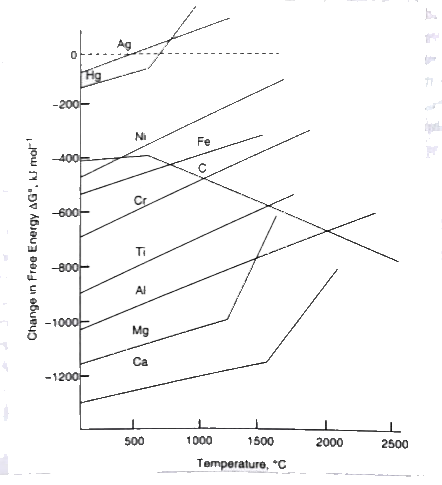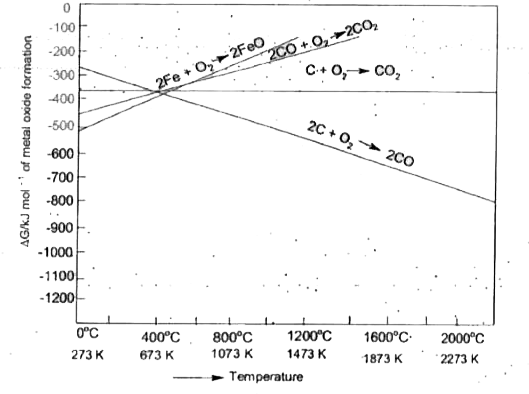At temperature above 1073K coke can be used to reduce FeO to Fe. How can you justify this reduction with Ellingham diagram?
To justify the reduction of FeO to Fe using coke at temperatures above 1073 K with the help of the Ellingham diagram, we can follow these steps:
1. Understanding the Ellingham Diagram:
- The Ellingham diagram is a plot of Gibbs free energy change (ΔG) versus temperature (T) for various reactions, particularly oxidation and reduction reactions. It helps predict the feasibility of reactions based on their ΔG values.
2. Identifying the Reactions:
- The reduction of iron(II) oxide (FeO) to iron (Fe) can be represented by the reaction:
FeO+C→Fe+CO
- This reaction involves two half-reactions:
- Reduction of FeO to Fe:
FeO+2e−→Fe+O2−
- Oxidation of carbon (C) to carbon monoxide (CO):
C+O2−→CO+2e−
3. Analyzing ΔG Values:
- From the Ellingham diagram, we can observe the ΔG values for the reactions:
- For the reaction FeO→Fe+12O2, the ΔG is positive at high temperatures (e.g., +220 kJ/mol at 1073 K).
- For the reaction C→CO, the ΔG is negative (e.g., -480 kJ/mol at 1073 K).
4. Combining the Reactions:
- The overall Gibbs free energy change (ΔR G) for the combined reaction can be calculated as:
ΔRG=ΔGC to CO+ΔGFeO to Fe
- Substituting the values:
ΔRG=(−480 kJ/mol)+(+220 kJ/mol)=−260 kJ/mol
- Since ΔR G is negative, the overall reaction is spontaneous.
5. Conclusion:
- At temperatures above 1073 K, the negative ΔR G indicates that the reaction of coke reducing FeO to Fe is thermodynamically favorable, justifying the use of coke as a reducing agent.
- The Ellingham diagram is a plot of Gibbs free energy change (ΔG) versus temperature (T) for various reactions, particularly oxidation and reduction reactions. It helps predict the feasibility of reactions based on their ΔG values.
- The reduction of iron(II) oxide (FeO) to iron (Fe) can be represented by the reaction:
FeO+C→Fe+CO
- This reaction involves two half-reactions:
- Reduction of FeO to Fe:
FeO+2e−→Fe+O2−
- Oxidation of carbon (C) to carbon monoxide (CO):
C+O2−→CO+2e−
- From the Ellingham diagram, we can observe the ΔG values for the reactions:
- For the reaction FeO→Fe+12O2, the ΔG is positive at high temperatures (e.g., +220 kJ/mol at 1073 K).
- For the reaction C→CO, the ΔG is negative (e.g., -480 kJ/mol at 1073 K).
- The overall Gibbs free energy change (ΔR G) for the combined reaction can be calculated as:
ΔRG=ΔGC to CO+ΔGFeO to Fe
- Substituting the values:
ΔRG=(−480 kJ/mol)+(+220 kJ/mol)=−260 kJ/mol
- Since ΔR G is negative, the overall reaction is spontaneous.
- At temperatures above 1073 K, the negative ΔR G indicates that the reaction of coke reducing FeO to Fe is thermodynamically favorable, justifying the use of coke as a reducing agent.
Topper's Solved these Questions
- BOOK - NCERT EXEMPLAR ENGLISHCHAPTER - GENERAL PRINCIPLE AND PROCESSES OF ISOLATION OF ELEMENTS EXERCISE - Matching The columns5videos
GENERAL PRINCIPLE AND PROCESSES OF ISOLATION OF ELEMENTS
- BOOK - NCERT EXEMPLAR ENGLISHCHAPTER - GENERAL PRINCIPLE AND PROCESSES OF ISOLATION OF ELEMENTS EXERCISE - Assertion and Reason5videos
GENERAL PRINCIPLE AND PROCESSES OF ISOLATION OF ELEMENTS
- BOOK - NCERT EXEMPLAR ENGLISHCHAPTER - GENERAL PRINCIPLE AND PROCESSES OF ISOLATION OF ELEMENTS EXERCISE - Long Answer Type Questions1videos
GENERAL PRINCIPLE AND PROCESSES OF ISOLATION OF ELEMENTS
- BOOK - NCERT EXEMPLAR ENGLISHCHAPTER - ELECTROCHEMISTRYEXERCISE - All Questions67videos
ELECTROCHEMISTRY
- BOOK - NCERT EXEMPLAR ENGLISHCHAPTER - HALOALKANES AND HALOARENESEXERCISE - Long Answer Type Questions3videos
HALOALKANES AND HALOARENES
Similar Questions
Indicate the temperature at which carbon can be used as a reducing agent for FeO.
View SolutionIndicate the temperature at which carbon can be used as a reducing agent for FeO.
View SolutionIndicate the temperature at which carbon can be used as a reducing agent for FeO.
View SolutionFe2O3 can be reduced by CO gas below 1123K. How do you relate this statement with ellingham diagram?
View SolutionCoke can be used to reduce Cu2O. Explain it based on thermodynamic view.
View SolutionCoke can be used to reduce Cu2O. Explain it based on thermodynamic view.
View SolutionIndicate the temperature at which carbon can be used as a reducing agent for FeO.
View SolutionFor a sponaneous reaction, the free energy change must be negative, ΔG=ΔH−TΔS,ΔH is the enthalpy change during the reaction. T is the absolute temperature, and ΔS is the change in entropy during the reaction. Consider a reaction such as the formation of an oxide
M+O2→MO
Dioxygen is used up in the course of this reaction. Gases have a more random structure (less ordered) than liquid or solids. Consequently gases have a higher entropy than liquids and solids. In this reaction S (entropy or randomness) decreases, hence ΔS is negative. Thus, if the temperature is raised then TΔS becomes more negative,Since, TΔS is substracted in the equation, then ΔG becomes less negative. Thus, the free energy change increases with the increase in temperature.
The free energy changes that occur when one mole of common reactant (in this case dioxygen) is used may be plotted graphically aginst temperature for a number of reactions of metals to their oxides. The following plot is called an Ellingham diagram for metal oxide. Understanding of Ellingham diagram is extremely important for the efficient extraction of metals.

Which of the following elements can be prepared by heating the oxide above 400∘C ?View Solution(a) Indicate the temperature at which carbon can be used as reducing agent for FeO.
(b) Define flux.
( c) Metal usually do not occur in nature as nitrates. Why ?
(d) Metal such as Cu,Ag,Zn etc. occur in nature as sulphide rather than oxides. Why ?View SolutionMetals are extracted from their ores by a wide variety of techniques. The most common ores are oxides. Most metals are obtained by direct treatment of theirs ores with chemical agents, but the extraction of certain others require electrolysis. An example of the former type of process is the extraction of iron from its oxide, described by the following equation :
Fe2O3+3C→2Fe+3CO
The relative ease of extraction of a metal from its oxide can be estimated using the Ellingham diagram, as shown in the figure.
The diagram plots the free energies of formation of various oxides per mole of consumed oxygen as a function of absolute temperature.

Which of the following best explains why the free energy of formation of Fe2O3 becomes less negative as the temperature is increased.View Solution

